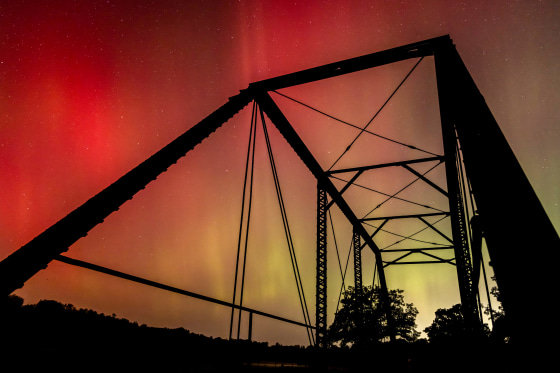
While Thanksgiving may be chilly and rainy in many parts of the nation, some Americans may be able to see the northern lights during solar storms.
According to the National Oceanic and Atmospheric Administration (NOAA), a filament eruption on Monday caused the sun to shoot a cloud of high-energy plasma toward Earth, increasing the likelihood of minor to major geomagnetic storms on Thursday and Friday.
The likelihood of the night skies in the United States turning green, crimson, and purple for Thanksgiving is presently being brought about by that eruption.
“The strength of the solar storms and whether they reach G1 or G2 conditions at all will determine how bright the auroras are and how long they stay in the skies,” NOAA meteorologist Mike Bettwy wrote in an email.
“This is not expected to be a widespread event and will likely only last for short intervals and could be quite faint in the affected locales,” Bettwy stated.
According to NOAA, people in northern regions of Idaho, Wyoming, New York, Vermont, and New Hampshire have a chance to see the aurora borealis this holiday weekend, as well as those in states like Washington, Montana, the Dakotas, Minnesota, Wisconsin, Michigan, and Maine.
Although it is unclear exactly when and where the skies will light up, NOAA experts predict that the aurora borealis will be visible from Thursday night until early Friday. They are predicting modest (G1) and moderate (G2) geomagnetic storms.
On NOAA’s Aurora Dashboard, viewers can follow the most recent activity and prediction in the hopes of catching a peek.Additionally, it provides short-term predictions for the northern lights, together with experimental techniques to measure their intensity and maps showing their projected viewing locations.
The brilliant lights are best viewed in clear circumstances. According to Bettwy, viewing opportunities will probably be restricted in areas of cloudiness over a large portion of the Northeast, New England, and the area around the Great Lakes.
According to Bettwy, unless the storms prove to be more powerful than anticipated, there shouldn’t be any serious delays to the nation’s communications networks this time around, unlike the bigger solar storms that gave many Americans a glimpse of the northern lights earlier this year.
Normally only visible at high elevations, the northern lights, also known as the aurora borealis, can be seen in places far further south than usual during strong enough solar storms.
When massive clouds of plasma are sent into space by the sun’s eruptions, known as coronal mass ejections, these solar storms occur. Radiant auroras are produced when those plasma clouds strike Earth because the plumes of charged particles collide with the planet’s magnetic field and interact with upper-atmosphere atoms and molecules.
The sun’s activity cycles from minimum to maximum last about 11 years. There have been several occasions this year when the northern lights have been visible so far south because the NOAA says it is preparing for an anticipated peak next July.
Note: Every piece of content is rigorously reviewed by our team of experienced writers and editors to ensure its accuracy. Our writers use credible sources and adhere to strict fact-checking protocols to verify all claims and data before publication. If an error is identified, we promptly correct it and strive for transparency in all updates, feel free to reach out to us via email. We appreciate your trust and support!
